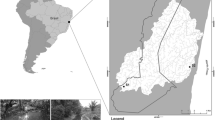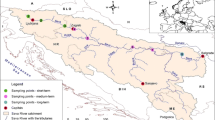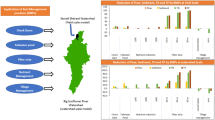Abstract
Land use and its relation to nutrient concentrations and loading via streams is an important issue in coastal lagoons and embayments worldwide including the Maryland coastal bays system, USA. As in many coastal areas around the globe, declining water quality in the bays is the result of nutrient inputs from the surrounding watershed. In this study, the sources of the nutrient inputs were examined. Monthly concentrations of total nitrogen (TN), ammonium (NH4 +), nitrate (NO3 -), phosphate (PO4 -3), and total phosphorus (TP) were measured in six streams in the St. Martin River basin from July 2006 to January 2008. Current land use information for the basins of each stream was also compiled. Several significant correlations between nutrients and land use type were found. The most significant correlation was with the land area of feeding operations, which demonstrated a significant positive relationship with mean baseflow TN concentrations. A similar relationship was also found with anthropogenic land area (cropland + urban + feeding operations), and wetland area was also positively associated with hydric soils. Using local water yields from a US Geological Survey station, annual stream watershed export was calculated using the concentration data, which indicated that the watershed with the most crop agriculture had the highest N export coefficient (20.4 kg N ha-1 year-1), while the highest P export (0.47 kg P ha-1 year-1) was in a watershed containing a nonoperational chicken hatchery and a subsequently modified channel. This suggests that agricultural development, especially animal feeding operations, and landscape characteristics are important factors to understand nutrient loading in St. Martin River and Maryland coastal bays. The methods used and the results determined in this study have implications for determining nutrient loading in lagoons and embayments, in relation to land use in coastal regions globally.









Similar content being viewed by others
References
Abit, S. Jr. (2005). Evaluation of subsurface solute transport and its contribution to nutrient load in the drainage ditches prior to restoration of a Carolina bay (pp. 137) (M.S. thesis) North Carolina State University: Raleigh, NC.
Andreasen, D. C., & Smith, B. S. (1997). Hydrogeology and simulation of ground-water flow in the Upper Wicomico River Basin and estimation of contributing areas of the city of Salisbury well fields, Wicomico County, Maryland. Maryland Geological Survey Report of Investigations No. 65, 87 pp.
Bachman, L. J., & Phillips, P. J. (1996). Hydrologic landscapes on the Delmarva Peninsula Part 2: Estimates of base-flow nitrogen load to Chesapeake Bay. Journal of the American Water Resources Association, 32, 779–791.
Beaulac, M. N., & Reckhow, K. H. (1982). An examination of land use–nutrient export relationships. Water Resources Bulletin, 18, 1013–1024.
Benitez, J. A. (2004). Land cover changes and impact on N and P export from the Choptank watershed (PhD thesis, University of Maryland).
Benitez, J. A., & Fisher, T. R. (2004). Historical land cover conversion (1665–1850) in the Choptank watershed, Eastern USA. Ecosystems, 7, 219–232.
Bennett, E. M., Reed-Andersen, T., Houser, J. N., Gabriel, J. R., & Carpenter, S. R. (1999). A phosphorus budget for the Lake Mendota watershed. Ecosystems, 2, 69–75.
Bennett, E. M., Carpenter, S. R., & Caraco, N. F. (2001). Human impact on erodable phosphorus and eutrophication: a global perspective. Bioscience, 51, 227–234.
Bohlen, C., Stokes, C., Goshorn, D., & Boynton, W. (1997). Today’s treasures for tomorrow: an environmental report on Maryland’s coastal bays. Maryland Department of Natural Resources, 36 pp.
Caddy, J. F. (1993). Toward a comparative evaluation of human impacts on fishery ecosystems of enclosed and semi-enclosed seas. Reviews in Fisheries Science, 1, 57–95.
Carpenter, S. R., Caraco, N. F., Correll, D. L., Howarth, R. W., Sharpley, A. N., & Smith, V. H. (1998). Nonpoint pollution of surface waters with phosphorus and nitrogen. Ecological Applications, 8, 559–568.
Costanzo, S. D., O’Donohue, M. J., Dennison, W. C., Loneragan, N. R., & Thomas, M. (2001). A new approach for detecting and mapping sewage impacts. Marine Pollution Bulletin, 42, 149–156.
Curran, J. C., & Robertson, M. (1991). Water quality implications of an observed trend of rainfall and runoff. Water and Environment Journal, 5, 419–424.
Dillow, J. J. A., & Greene, E. A. (1999). Ground-water discharge and nitrate loadings to the coastal bays of Maryland. US Geological Survey MD0DE-DC Water Science Center, WRIR 99–4167.
Fertig, B., Carruthers, T., Wazniak, C., Sturgis, B., Hall, M., Jones, A., & Dennison, W. (2006). Water quality in four regions of the Maryland coastal bays: assessing nitrogen source in relation to rainfall and brown tide. Data report to Maryland Coastal Bays Program.
Fisher, D. C., & Oppenheimer, M. (1991). Atmospheric nitrogen deposition and the Chesapeake bay estuary. Ambio, 23, 102–208.
Fisher, T. R., Lee, K.-Y., Berndt, H., Benitez, J. A., & Norton, M. M. (1998). Hydrology and chemistry of the Choptank River basin in the Chesapeake bay drainage. Water, Air, and Soil Pollution, 105, 387–397.
Fisher, T. R., Hagy, J. D., III, Boynton, W. R., & Williams, M. R. (2006). Cultural eutrophication in the Choptank and Patuxent estuaries of Chesapeake Bay. Limnology and Oceanography, 51, 435–447.
Foy, R. H., & Withers, P. J. A. (1995). The contribution of agricultural phosphorus to eutrophication. Proceedings of the Fertilizer Society, 365, 32.
Gächter, R., Steingruber, S. M., Reinhardt, M., & Wehrli, B. (2004). Nutrient transfer from soil to surface waters: differences between nitrate and phosphate. Aquatic Science, 66, 117–122.
Glibert, P. M., Wazniak, C. E., Hall, M., & Sturgis, B. (2007). Seasonal and interannual trends in nitrogen in Marylan’s coastal bays and relationships with brown tide. Ecological Applications, 17, S79–S87.
Hager, P. (1996). Worcester County, MD, pp. 20–24. In K. Beidler, P. Gant, M. Ramsay, & G. Schultz (Eds.), Proceedings Delmarva’s coastal bay watersheds: Not yet up the creek. EPA/600/R-95/052. U.S. Environmental Protection Agency, National Health and Environmental Effects Research Laboratory, Atlantic Ecology Division, Narragansett, RI, USA.
Johnston, R. H. (1973). Hydrology of the Columbia (Pleistocene) deposits of Delaware: an appraisal of a regional water-table aquifer: Delaware Geological Survey Bulletin No. 14, 78 pp.
Johnston, R. H. (1977). Digital model of the unconfined aquifer in central and southeastern Delaware: Delaware Geological Survey Bulletin No. 15, 47 pp.
Jones, A. B., Carruthers, T. J., Pantus, F., Thomas, J., Saxby, T. A., & Dennison, W. (2004). A water quality assessment of the Maryland coastal bays including nitrogen source identification using stable isotopes. Final report to the Maryland Coastal Bays Program.
Jordan, T. E., Correll, D. L., & Weller, D. E. (1997a). Relating nutrient discharges from watersheds to land use and streamflow variability. Water Resources Research, 33, 2579–2590.
Jordan, T. E., Correll, D. L., & Weller, D. E. (1997b). Effects of agriculture on discharges of nutrients from Coastal Plain watersheds of Chesapeake Bay. Journal of Environmental Quality, 26, 836–848.
Jordan, T. E., Correll, D. L., & Whigham, D. F. (1983). Nutrient flux in the Rhode River: Tidal exchange of nutrients by brackish marshes. Estuarine Coastal and Shelf Science, 17, 651–667.
Koskelo, A. (2008). Hydrologic and biogeochemical storm response in Choptank Basin headwaters (M.S. thesis, Marine-Estuarine-Environmental Sciences, University of Maryland Center for Environmental Sciences).
Lee, K.-Y., Fisher, T. R., & Rochelle-Newall, E. (2001). Modeling the hydrochemistry of the Choptank River basin using GWLF and Arc/Info 2: Model validation and application. Biogeochemistry, 56, 311–348.
Lefebvre, S., Clement, J. C., Pinay, G., Thenail, C., Durand, P., & Marmonier, P. (2007). 15N-nitrate signature in low-order streams: effects of land cover and agricultural practices. Ecological Applications, 17, 2333–2346.
Lowrance, R. R., Fail, T. J., Hendrickson, O., Leonard, R., & Asmussen, L. (1984). Riparian forests as nutrient filters in agricultural watersheds. BioScience, 34, 374–377.
Marchetti, R., & Verna, N. (1992). Quantification of the phosphorus and nitrogen loads in the minor rivers of the Emilia-Romagna coast (Italy). A methodological study on the use of theoretical coefficients in calculating the loads. Science of the Total Environment, 126(Supplement), 315–336.
Maryland Department of Environment. (2000). Total maximum daily loads of nitrogen and phosphorus for five tidal tributaries in the northern coastal bays system, Worcester County, MD. MDE Report II, October 2000.
Noe, G. B., & Hupp, C. R. (2005). Carbon, nitrogen, and phosphorus accumulation in floodplains of Atlantic coastal plain rivers, USA. Ecological Applications, 15, 1178–1190.
Norton, M. M., & Fisher, T. R. (2000). The effects of forest on stream water quality in two coastal plain watersheds of the Chesapeake Bay. Ecological Engineering, 14, 337–362.
Novotny, V., & Olem, H. (1994). Water quality, prevention, identification, and management of diffuse pollution. New York: Van Nostrand Reinhold.
Peierls, B. L., Caraco, N. F., Pace, M. L., & Cole, J. J. (1991). Human influence on river nitrogen. Nature, 350, 386–387.
Peterjohn, W. T., & Correll, D. L. (1984). Nutrient dynamics in an agricultural watershed: observations on the role of a riparian forest. Ecology, 65, 1466–1475.
Pionke, H. B., Gburek, W. J., & Sharpley, A. N. (2000). Critical source area controls on water quality in an agricultural watershed located in the Chesapeake Basin. Ecological Engineering, 14, 325–335.
Primrose, N. L. (2001). Report on nutrient synoptic surveys in the Isle of Wight watershed, Worcester County, Maryland, April 2001 as part of the watershed restoration action strategy. Watershed Evaluation Section, Maryland Department of Natural Resources.
Reckhow, K. H., & Simpson, J. T. (1980). A procedure using modeling and error analysis for the prediction of lake phosphorus concentration from land use information. Canadian Journal of Fisheries and Aquatic Science, 37, 1439–1448.
Ritter, W. F. (1986). Water quality of agricultural coastal plain watersheds. Agricultural Wastes, 16, 201–216.
Ritter, W. F., & Harris, J. R. (1984). Nonpoint source nitrogen loads to Delaware lakes and streams. Agricultural Wastes, 9, 35–50.
Roth, N. E., Southerland, M. T., Rogers, G. M., & Volstad, J. H. (2003). Maryland biological stream survey 2000–2004. Volume II: Ecological assessment of watersheds sampled in 2001. Prepared by Versar, Columbia, MD with Maryland Department of Natural Resources, Monitoring and Non-Tidal Assessment Division.
Scheffer, F., Schachtschabel, P., Blume, H. P., Brümmer, G., Hartge, K. H., Schwertmann, U., et al. (1992). Book of soil science (p. 491). Stuttgart: Enke.
Sharpley, A., Meisinger, J. J., Breeuwsma, A., Sims, J. T., Daniel, T. C., & Shepers, J. S. (1997). Impacts of animal manure management on ground and surface water quality. In J. L. Hatfield, & B. A. Stewart (Eds), Animal waste utilization: effective use of manure as a soil resource (pp. 320). Boca Raton, FL: CRC Press.
Stutter, M. I., Langan, S. J., & Cooper, R. J. (2008). Spatial contributions of diffuse inputs and within-channel processes to the form of stream water phosphorus over storm events. Journal of Hydology, 350, 203–214.
Trimble, S. W. (1997). Contribution of stream channel erosion to sediment yield from an urbanizing watershed. Science, 21, 1442–1444.
US Department of Agriculture (2002). 2002 Census of agriculture. Available at http:www.nass.usda.gov/Census/Create_Census_US_CNTY.jsp. Accessed 7 July 2008.
US Department of Agriculture, Natural Resources Conservation Service. (2008). Web soil survey. Available at http://websoilsurvey.nrcs.usda.gov/app/WebSoilSurvey.aspx. Accessed 7 July 2008.
Volk, J. A., Savidge, K. B., Scudlark, J. R., Andres, A. S., & Ullman, W. J. (2006). Nitrogen loads through baseflow, stormflow, and underflow to Rehoboth Bay, Delaware. Journal of Environmental Quality, 35, 1742–1755.
Wahl, M. H., McKellar, H. N., & Williams, T. M. (1997). Patterns of nutrient loading in forested and urbanized coastal streams. Journal of Experimental Marine Biology and Ecology, 213, 111–131.
Wazniak, C. E., Hall, M. R., Cain, C., Wilson, D., Jesien, R., Thomas, J., Carruthers, T., & Dennison, W. C. (2004). State of the Maryland coastal bays report.
Wazniak, C. E., Hall, M. R., Carruthers, T. J. B., Sturgis, B., Dennison, W. C., & Orth, R. J. (2007). Linking water quality to living resources in a mid-Atlantic lagoon system, USA. Ecological Applications, 17(Supplement), S64–S78.
Whigham, D. F., Chitterling, C., & Palmer, B. (1988). Impacts of freshwater wetlands on water quality: a landscape perspective. Environmental Management, 12, 663–671.
Acknowledgments
We would like to thank Carol Cain for access to stream nutrient data, Greg Radcliffe and Ben Fertig for their assistance with GIS, and Horn Point Analytical Services for analysis of water samples. This research was supported by a Maryland Coastal Bays Program implementation grant and a Horn Point Small Grant and Student Fellowship to K.A. Beckert UMCES contribution # 4500.
Author information
Authors and Affiliations
Corresponding author
Rights and permissions
About this article
Cite this article
Beckert, K.A., Fisher, T.R., O’Neil, J.M. et al. Characterization and Comparison of Stream Nutrients, Land Use, and Loading Patterns in Maryland Coastal Bay Watersheds. Water Air Soil Pollut 221, 255–273 (2011). https://doi.org/10.1007/s11270-011-0788-7
Received:
Accepted:
Published:
Issue Date:
DOI: https://doi.org/10.1007/s11270-011-0788-7




